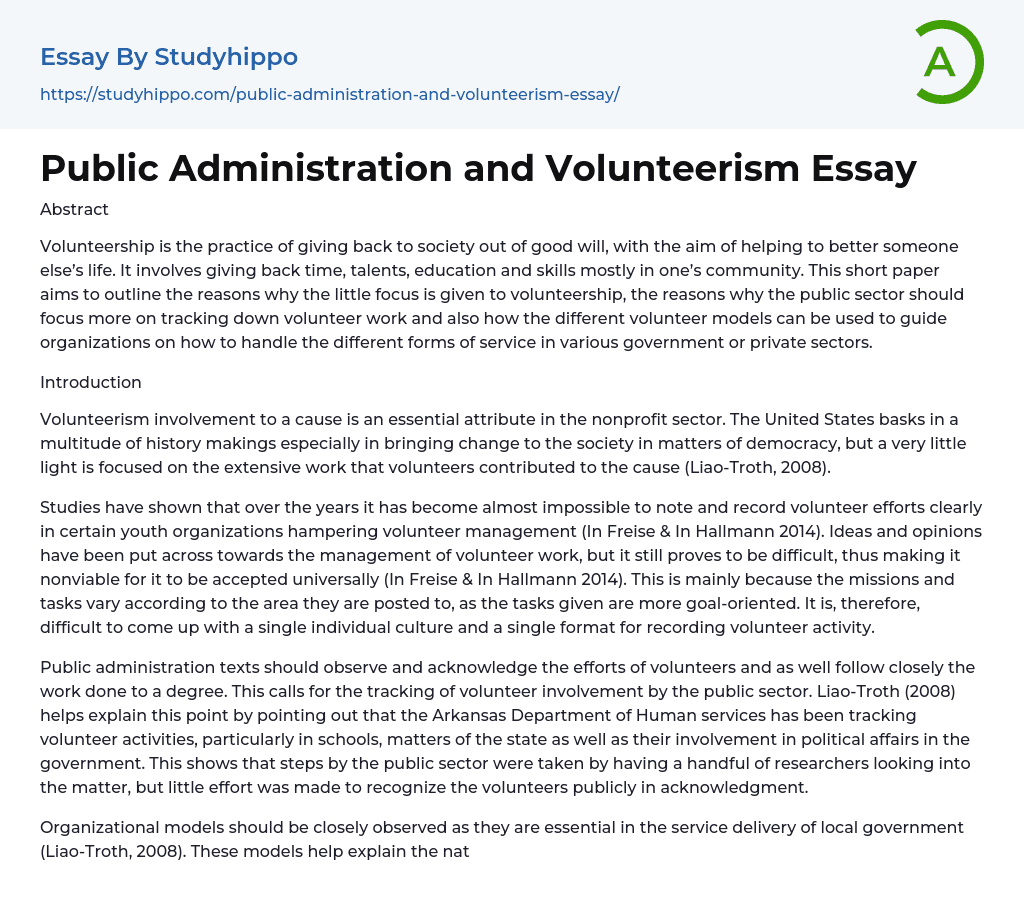Abstract
Volunteership is the practice of giving back to society out of good will, with the aim of helping to better someone else’s life. It involves giving back time, talents, education and skills mostly in one’s community. This short paper aims to outline the reasons why the little focus is given to volunteership, the reasons why the public sector should focus more on tracking down volunteer work and also how the different volunteer models can be used to guide organizations on how to handle the different forms of service in various government or private sectors.
Introduction
Volunteerism involvement to a cause is an essential attribute in the nonprofit sector. The United States basks in a multitude of history makings especially in bringing change to the society in matters of democracy, but a very little light is focused on the extensive work
...that volunteers contributed to the cause (Liao-Troth, 2008).
Studies have shown that over the years it has become almost impossible to note and record volunteer efforts clearly in certain youth organizations hampering volunteer management (In Freise & In Hallmann 2014). Ideas and opinions have been put across towards the management of volunteer work, but it still proves to be difficult, thus making it nonviable for it to be accepted universally (In Freise & In Hallmann 2014). This is mainly because the missions and tasks vary according to the area they are posted to, as the tasks given are more goal-oriented. It is, therefore, difficult to come up with a single individual culture and a single format for recording volunteer activity.
Public administration texts should observe and acknowledge the efforts of volunteers and as well follow closely the work don
to a degree. This calls for the tracking of volunteer involvement by the public sector. Liao-Troth (2008) helps explain this point by pointing out that the Arkansas Department of Human services has been tracking volunteer activities, particularly in schools, matters of the state as well as their involvement in political affairs in the government. This shows that steps by the public sector were taken by having a handful of researchers looking into the matter, but little effort was made to recognize the volunteers publicly in acknowledgment.
Organizational models should be closely observed as they are essential in the service delivery of local government (Liao-Troth, 2008). These models help explain the nature of volunteership, be it short-term or long-term and they explain in depth how organizations should handle the different forms of service in various government or private sectors. The public sector is held in high regard by major political figures in the US as they draw their attention closely to volunteerism. Classic examples of past political icons are J.F Kennedy who called people to serve through the Peace Corps as well as Bill Clinton whose trademark was AmeriCorps which used the same to call volunteers to support and work through his campaigns (Liao-Troth,2008). The Obama campaign in 2008 is a clear example of how most of the campaign was mainly done by volunteers who tirelessly worked to collect funds and gain support from the youth in the enhancement of the election as a whole.
Conclusion
In conclusion to this, the United Nations has been exceptional in the realization and management of the importance of volunteerism. It stressed upon the need for various governments to embrace and support volunteers
by creating legal frameworks and formulating strategies to facilitate as well as support volunteers all over the world. This embraces the aspect of diversity especially ethnic, where different people from all parts of the world come together to support a common cause as well as bring diverse knowledge and skills to a better world thereof. It is important to include education as an essential factor in volunteers. This is where the realization of democracy comes in, as it shows the level at which the participants are prepared to fit in a diverse world within an ever more dissimilar society.
References
- Dancy, T. E. (2010). Managing diversity: (re)visioning equity on college campuses. New York:
Peter Lang. - In Freise, M., & In Hallmann, T. (2014). Modernizing democracy: Associations and associating
in the 21st Century. - Liao-Troth, M. A. (2008). Challenges in volunteer management. Charlotte, N.C: IAP-
Information Age Pub.
- Abraham Lincoln essays
- Andrew Jackson essays
- Barack Obama essays
- Bill Clinton essays
- Donald Trump essays
- Franklin D. Roosevelt essays
- George W. Bush essays
- George Washington essays
- James Madison essays
- John F. Kennedy essays
- Lyndon B. Johnson essays
- Richard Nixon essays
- Theodore Roosevelt essays
- Thomas Jefferson essays
- Vice President essays
- Accident essays
- Awareness essays
- Benefits of Volunteering essays
- Challenges essays
- Childhood Memories essays
- Decision essays
- Driving essays
- Event essays
- Excellence essays
- Expectations essays
- Failure essays
- Farewell essays
- Flight essays
- Gift essays
- Growing Up essays
- Ignorance essays
- Improve essays
- Incident essays
- Knowledge essays
- Luck essays
- Memories essays
- Mistake essays
- Obstacles essays
- Overcoming Challenges essays
- Party essays
- Peace Corps essays
- Personal Experience essays
- Problems essays
- Sacrifices essays
- Struggle essays
- Success essays
- Trust essays
- Vacation essays
- Visit essays
- Volunteering essays




